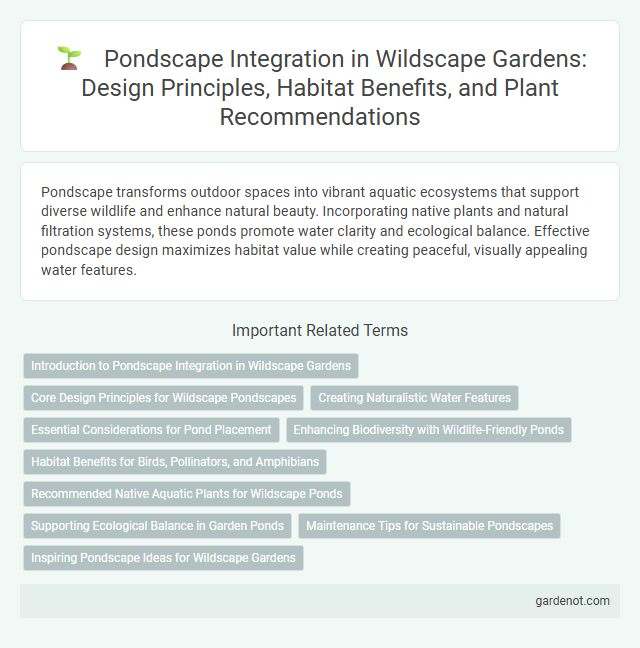Pondscape transforms outdoor spaces into vibrant aquatic ecosystems that support diverse wildlife and enhance natural beauty. Incorporating native plants and natural filtration systems, these ponds promote water clarity and ecological balance. Effective pondscape design maximizes habitat value while creating peaceful, visually appealing water features.
Introduction to Pondscape Integration in Wildscape Gardens
Pondscape integration in Wildscape gardens enhances biodiversity by creating aquatic habitats that support native flora and fauna such as dragonflies, amphibians, and water plants. These eco-friendly water features improve garden aesthetics while promoting natural water filtration and erosion control. Incorporating Pondscapes encourages sustainable gardening practices by mimicking natural wetland ecosystems.
Core Design Principles for Wildscape Pondscapes
Wildscape Pondscapes prioritize creating biodiverse aquatic habitats that support native flora and fauna, emphasizing natural water filtration and sustainable ecosystem balance. Core design principles include shallow shelves for amphibian breeding, diverse plant zones for wildlife shelter, and strategic microhabitats to enhance species richness. Integration of native vegetation and organic substrate layers ensures long-term ecological resilience and minimal maintenance.
Creating Naturalistic Water Features
Pondscape involves designing naturalistic water features that enhance biodiversity and support local ecosystems by mimicking natural pond environments. Incorporating native aquatic plants and organic materials such as rocks and logs encourages habitat creation for amphibians, insects, and birds. Proper water circulation and filtration systems ensure ecological balance while maintaining water clarity and health within the Pondscape.
Essential Considerations for Pond Placement
When planning a pondscape, essential considerations for pond placement include sunlight exposure, soil type, and proximity to trees. Optimal sunlight promotes aquatic plant growth while avoiding excessive algae, and stable, well-draining soil ensures structural integrity. Placing the pond away from overhanging trees minimizes leaf litter and root intrusion, maintaining water quality and reducing maintenance.
Enhancing Biodiversity with Wildlife-Friendly Ponds
Wildscape's Pondscape designs prioritize enhancing biodiversity by creating wildlife-friendly ponds that support diverse aquatic and terrestrial species. These ponds incorporate native plants, shallow edges, and varied habitats to attract amphibians, insects, and birds, fostering a balanced ecosystem. Integrating sustainable water management techniques ensures year-round habitat stability critical for local wildlife conservation.
Habitat Benefits for Birds, Pollinators, and Amphibians
Pondscapes provide essential aquatic habitats that support diverse bird species by offering feeding, nesting, and breeding grounds. These water features create microhabitats rich in flowering plants, attracting pollinators such as bees and butterflies crucial for ecosystem health. Amphibians benefit from the clean, slow-moving water and abundant vegetation, essential for their life cycles and population stability.
Recommended Native Aquatic Plants for Wildscape Ponds
Recommended native aquatic plants for Wildscape ponds include pickerelweed (Pontederia cordata), which provides vibrant purple flowers and essential habitat for pollinators. Native water lilies (Nymphaea odorata) offer surface coverage that reduces algae growth and enhances oxygen levels crucial for pond ecosystems. Cattails (Typha latifolia) are vital for water filtration, sediment stabilization, and providing shelter for wildlife in Wildscape environments.
Supporting Ecological Balance in Garden Ponds
Pondscape enhances garden ponds by integrating native aquatic plants and natural filtration systems that support biodiversity and water quality. This ecological design promotes habitats for amphibians, insects, and birds, fostering a vibrant, balanced ecosystem. Maintaining these natural elements reduces algae growth and stabilizes pond conditions, ensuring long-term sustainability.
Maintenance Tips for Sustainable Pondscapes
Regularly removing debris and controlling algae growth are essential maintenance tips for sustainable pondscapes, ensuring clear water and healthy aquatic life. Introducing native plants supports biodiversity and stabilizes pond banks, reducing erosion and nutrient runoff. Monitoring water quality parameters such as pH, dissolved oxygen, and nutrient levels helps maintain a balanced ecosystem and prevents harmful conditions.
Inspiring Pondscape Ideas for Wildscape Gardens
Creating a vibrant pondscape in wildscape gardens enhances biodiversity by attracting native amphibians, dragonflies, and birds. Incorporate native aquatic plants such as water lilies, cattails, and submerged pondweeds to improve water quality and provide natural habitats. Use irregular shapes and shallow edges to mimic natural ponds, promoting a balanced ecosystem and supporting local wildlife populations.
Pondscape Infographic

 gardenot.com
gardenot.com